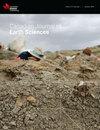在Al2O3 - CaO*+Na2O - K2O - FeO+MgO (A-CN-K-FM)三维组成空间中探讨了硅质碎屑沉积物和沉积岩的岩石成因
IF 1.6
4区 地球科学
Q3 GEOSCIENCES, MULTIDISCIPLINARY
引用次数: 24
摘要
40年前,随着化学蚀变指数(CIA)的建立,定量确定沉积岩中化学风化作用(和风化剖面)的数量迈出了重要的一步。CIA将不动铝的比例与可动阳离子钙、钠和钾联系起来,并以水解过程中发生的矿物反应的经验和模拟地球化学数据为基础。然而,CIA应谨慎应用,因为它是一个一维值,在最复杂的情况下,如碎屑沉积岩,均质化了物源、风化、分选和成岩作用的成分输入。随后建立了二维三元图(Al2O3-CaO *+ Na2O-K2O;Al2O3-CaO *+Na2O+ K2O-FeO +MgO)允许在可能分离这些输入的数据集中探索矿物-地球化学途径的能力,但解释三元图可能很复杂,因为它们区分和分组某些元素。在这里,我们建立了一个三维四面体图(Al2O3-CaO *+ na20 - k20 - feo +MgO, a - cn - k - fm),它包含了相同的关键元素,并允许在同一图上同时评估长英质和基性岩石和矿物,同时保留了将斜长石与碱长石分离并监测沉积后钾变化的能力。利用四面体图,我们发现在二维三元图上的CIA值和位置都可能产生潜在的误导性解释,而没有适当地并行预算氧化铁成分。我们首先展示了四面体是如何工作的,然后用它与许多先前发表的例子来确定相互竞争的基性和长英质输入如何塑造烃源岩的组成,风化剖面,在沉积岩石成因中积极运输沉积物,古土壤和沉积岩。本文章由计算机程序翻译,如有差异,请以英文原文为准。
Petrogenesis of siliciclastic sediments and sedimentary rocks explored in three-dimensional Al2O3 – CaO*+Na2O – K2O – FeO+MgO (A-CN-K-FM) compositional space
Quantitatively determining the amount of chemical weathering within sedimentary rocks (and weathering profiles) took a major step forward with the creation of the chemical index of alteration (CIA) forty years ago. The CIA relates the proportion of immobile aluminum to the mobile cations calcium, sodium, and potassium and is grounded in empirical and modeled geochemical data for mineral reactions that occur during hydrolysis. However, the CIA should be applied cautiously because it is a one-dimensional value that in the most complex situations, as with clastic sedimentary rocks, homogenizes the compositional inputs of source, weathering, sorting, and diagenesis. Subsequently developed two-dimensional ternary diagrams (Al2O3–CaO*+Na2O–K2O; Al2O3–CaO*+Na2O+K2O–FeO+MgO) permitted the capacity to explore mineralogical-geochemical pathways in data sets that may separate those inputs, but interpreting the ternary diagrams may be complicated because they differentiate and group certain elements. Here we develop a three-dimensional tetrahedral diagram (Al2O3–CaO*+Na2O–K2O–FeO+MgO, A-CN-K-FM) that incorporates the same critical elements and permits the simultaneous assessment of felsic and mafic rocks and minerals on the same diagram, while retaining the ability to separate plagioclase from alkali feldspar and monitor post-depositional potassium changes. Using the tetrahedral plot, we show that both the CIA value and positions on the 2D ternary diagrams can generate potentially misleading interpretations without properly budgeting the ferromagnesian components in parallel. We first show how the tetrahedron works, then use it with numerous previously published examples to identify how the competing mafic and felsic inputs shape the composition of source rocks, weathering profiles, actively transporting sediment, paleosols, and sedimentary rocks in sedimentary petrogenesis.
求助全文
通过发布文献求助,成功后即可免费获取论文全文。
去求助
来源期刊

Canadian Journal of Earth Sciences
地学-地球科学综合
CiteScore
2.80
自引率
7.10%
发文量
66
审稿时长
6-12 weeks
期刊介绍:
The Canadian Journal of Earth Sciences reports current research in climate and environmental geoscience; geoarchaeology and forensic geoscience; geochronology and geochemistry; geophysics; GIS and geomatics; hydrology; mineralogy and petrology; mining and engineering geology; ore deposits and economic geology; paleontology, petroleum geology and basin analysis; physical geography and Quaternary geoscience; planetary geoscience; sedimentology and stratigraphy; soil sciences; and structural geology and tectonics. It also publishes special issues that focus on information and studies about a particular segment of earth sciences.
 求助内容:
求助内容: 应助结果提醒方式:
应助结果提醒方式:


